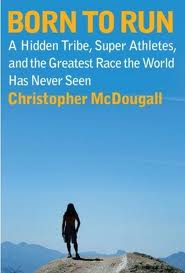“Here are some who like to run. They run for fun in the hot, hot sun. Oh me! Oh my! Oh me! Oh my! What a lot of funny things go by.” – Dr. Suess
 The other day I picked up, and started reading Christopher McDougall’s 2009 meditation of all things running, Born To Run: A Hidden Tribe, Superathletes, and the Greatest Race the World Has Never Seen. It is the fantastic story of how “the blissful Tarahumara Indians” of “Mexico’s deadly Copper Canyons … have honed the ability to run hundreds of miles without rest or injury,” reads the blurb on the back of the book.
The other day I picked up, and started reading Christopher McDougall’s 2009 meditation of all things running, Born To Run: A Hidden Tribe, Superathletes, and the Greatest Race the World Has Never Seen. It is the fantastic story of how “the blissful Tarahumara Indians” of “Mexico’s deadly Copper Canyons … have honed the ability to run hundreds of miles without rest or injury,” reads the blurb on the back of the book.
(Despite its title, it has nothing to do with Bruce Springsteen. In fact, my reading of Born To Run has bizarrely been paired by rediscovering, and listening non-stop to Mazzy Star, in order that “Fade Into You” is the constant in-head background noise as I speed-read my way through this tale of physical overexertion combined with something approaching spiritual happiness. This strenous connection could have something to do with the idea of easing into a run, which seems perfectly expressed in every Mazzy Star song, or could be the remnants of a Brain Pickings/Literary Jukebox blog post I read a week or so ago. Or just a nonsensical coincidence that is enjoyable nonetheless. Like this paragraph, perhaps.)
At its simplest, Born To Run is about our deep human connection to the activity of running. “When things look worst,” McDougall writes, “we run the most. Three times, America has seen distance-running skyrocket, and it’s always in the midst of a national crisis.” The first occurred during the Great Depression, then in the 1970’s, “when we were struggling to recover from Vietnam, the Cold War, race riots, a criminal president, and the murders of three beloved leaders,” continues McDougall. And the most recent was after 9-11, when “trail-running suddenly became the fastest growing outdoor sport in the country.”
Why is there such a deep human connection to running? “Running unites our two most primal impulses: fear and pleasure,” suggests McDougall. “We run when we’re scared, we run when we’re ecstatic, we run away from our problems, and run around for a good time.” (Any parent of young children can certainly attest to that.)
So then, why is running such a chore? Because we do it the wrong way. A recent Brain Pickings post outlines the suggestions of Daniel Lieberman, evolutionary biologist at Harvard University (see video below):
1. Don’t overstride.
2. Do land with a flat foot.
3. Do run vertically.
4. Don’t “thump.”
5. Do ease into it.
 Born To Run has helped spark a debate around the concept of “barefoot running,” and its commercial correlary “barefoot running shoes.” On one hand, this is appropriate. The Tarahumara’s athletic footwear of choice of a simple flat sandal with a leather strap lends credibility to McDougall’s criticism of the running shoe industry, which the author claims over-cushions our feet to the extent that, especially in the past 30 years or so, we’ve collectively forgotten how to run. But on the other hand, this debate is complicit in the rise of the truly horrific “Five Fingers” running shoe (see photo).
Born To Run has helped spark a debate around the concept of “barefoot running,” and its commercial correlary “barefoot running shoes.” On one hand, this is appropriate. The Tarahumara’s athletic footwear of choice of a simple flat sandal with a leather strap lends credibility to McDougall’s criticism of the running shoe industry, which the author claims over-cushions our feet to the extent that, especially in the past 30 years or so, we’ve collectively forgotten how to run. But on the other hand, this debate is complicit in the rise of the truly horrific “Five Fingers” running shoe (see photo).
We’ll have more on all of this later (I’m only halfway through the book). For now, I need to put on my running sneakers and hit the trail.
I hope my Osgood-Schlatter holds up.


